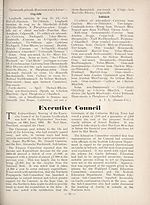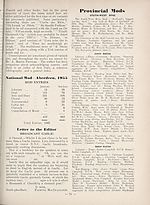An Comunn Gàidhealach Publications > Gaidheal > Volume 49--51, January 1954--December 1956
(328) Page 74
Download files
Complete book:
Individual page:
Thumbnail gallery: Grid view | List view

The Propaganda Committee reported that an
appeal had been sent to branches and provincial
mod areas asking them to recruit members,
and help in selling Gaelic publications. It was
noted, with satisfaction, that all the members
of the Manchester Branch were Representative
Members of An Comunn. It was reported that
the Wester Ross and South Uist Mods would
not be held this year, and that the Kintyre
Mod was being held on 16th and 17th June.
The Committee expressed appreciation of the
proposal made at a recent conference in Inver¬
ness that there be a separate festival of Gaelic
Plays; as distinct from the Scottish Community
Drama Association Festival. In discussion
on this matter in the Council, it was evident
that several members, while approving of an
all-Gaelic Drama Festival, insisted that Gaelic
plays should still be eligible for the S.C.D.A.
Festival. Satisfaction was expressed at the
News-letter recently issued by the Northern
Propaganda Sub-Committee. The Northern
Propaganda Sub-Committee had sent letters
of appreciation to the Editor of The Stornoway
Gazette for the place given to Gaelic in that
newspaper, and to Mr. Hugh Smith, School¬
master, Brevig, Barra, for articles by his
pupils which had appeared m An Gaidheal Og.
The Art and Industry Committee reported
that its section of the Syllabus for the 1956
National Mod had been prepared.
The Mod and Music Committee reported on
arrangements for the forthcoming National
Mod at Aberdeen, from 26th to 30th September.
The Chairman at the Mod Concerts would be:
Junior Concert, Mr. Frank Scorgie (Director of
Education for Aberdeen); Rural Choirs Concert,
Rev. Professor John M. Graham; and Grand
Concerts, Lord Provost Stephen and Lord
Aberdeen. The Official Opening would be in
the Music Hall, Aberdeen, on Monday, 26th
September, at 7.30 p.m. The Mod Gaelic
Service would be held on 25th September and
would be conducted by the Rev. Norman
Macdonald. Arrangements are being made for
a “Mod Club.’' Delegates were appointed as
follows: to the Oireachtas, Mr. D. J. Maclean
(Northern Organiser) and Rev. T. M. Murchison
(Vice-President); and to the Eisteddfod, Mrs.
C. M. B. Dunlop and Mrs. J. M. B. Maclean.
The Accounts and Reports for the year 1954-55
were submitted and approved, nominations for
the various offices which fall vacant at this time
were reported on, and intimation was given of
notices'of motion to be considered at the annual
general meeting on 1st October.
The meeting concluded with a vote of thanks
to the Chairman.
Folksongs and Folklore of South Uist, by
Margaret Fay Shaw. (Routledge & Kegan r:
Paul, London. 50/-).
Anyone who knows anything of Canna under
the regime of the present laird, John Lome
Campbell, knows that it is a hive of industry
as regards the study of Gaelic material. The j
publications of Mr. Campbell are well known ]
to the Gaelic public: here we have Mrs. j
Campbell, or Margaret Fay Shaw, offering her j
first major contribution to work in the Gaelic i
or Highland field. Her name was already !
known to students of folk-music through her
publication of thirteen Gaelic songs from Uist
in the Journal of the English Folk Dance and
Song Society, Vol. 5.
This book, although it is mainly concerned
with Gaelic songs, covers a much wider field
than that. It is indeed an attempt to present I
a picture of a remote Hebridean community, I
in its work and its recreation, at a period I
(1920-35) when social, economic and cultural j
change was only beginning to threaten it. The ■
picture presented is already somewhat out of ■
date: that is part of its value. If it seems I
partly antiquarian, it is not falsely so, and it ■
gives a picture, and an assessment of a mode of '■
life which was common, in various degrees, to '■
many parts of the Hebrides. If it survives at .U
all now, it is in comers even more remote than 'jl
Glen Dale, South Uist, where Margaret Fay >■
Shaw lived and worked in the early Thirties. )
The account given is a composite one, appeal-
ing to the eye and the ear and the mind. We H
have a lavish selection of photographs, of $
landscape, of people, of houses, implements j
and the like. These are presented with a warmth i
of sympathy. Selected aspects of the life are !
presented in greater detail: the traditional |
mode of thought is suggested in a selection of
proverbs and sayings, and in stories told by
Seonaidh Caimbeul, the best-known of a family
of local bards. The marvellous and the practical
are blended in a selection of cures for various
ailments. That for a stiff neck, I noticed
without relief, is to “put the tongs about the
neck and massage back and forth.” Another
interesting section deals with recipes for dishes.
The main section of the book is that on the
songs, with Gaelic text and English translation, ,
staff notation, references and notes. In all, \
109 songs are given, 34 of these being waulking
songs. It is a collection of great interest and
variety, ranging over four centuries down to the
middle of the present one. Many of these songs
have already been published in collections such
as An t-Oranaiche, K. C. Craig’s Grain Luaidh,
Frances Tolmie’s collection of 1911, Eilean
— 74 —
appeal had been sent to branches and provincial
mod areas asking them to recruit members,
and help in selling Gaelic publications. It was
noted, with satisfaction, that all the members
of the Manchester Branch were Representative
Members of An Comunn. It was reported that
the Wester Ross and South Uist Mods would
not be held this year, and that the Kintyre
Mod was being held on 16th and 17th June.
The Committee expressed appreciation of the
proposal made at a recent conference in Inver¬
ness that there be a separate festival of Gaelic
Plays; as distinct from the Scottish Community
Drama Association Festival. In discussion
on this matter in the Council, it was evident
that several members, while approving of an
all-Gaelic Drama Festival, insisted that Gaelic
plays should still be eligible for the S.C.D.A.
Festival. Satisfaction was expressed at the
News-letter recently issued by the Northern
Propaganda Sub-Committee. The Northern
Propaganda Sub-Committee had sent letters
of appreciation to the Editor of The Stornoway
Gazette for the place given to Gaelic in that
newspaper, and to Mr. Hugh Smith, School¬
master, Brevig, Barra, for articles by his
pupils which had appeared m An Gaidheal Og.
The Art and Industry Committee reported
that its section of the Syllabus for the 1956
National Mod had been prepared.
The Mod and Music Committee reported on
arrangements for the forthcoming National
Mod at Aberdeen, from 26th to 30th September.
The Chairman at the Mod Concerts would be:
Junior Concert, Mr. Frank Scorgie (Director of
Education for Aberdeen); Rural Choirs Concert,
Rev. Professor John M. Graham; and Grand
Concerts, Lord Provost Stephen and Lord
Aberdeen. The Official Opening would be in
the Music Hall, Aberdeen, on Monday, 26th
September, at 7.30 p.m. The Mod Gaelic
Service would be held on 25th September and
would be conducted by the Rev. Norman
Macdonald. Arrangements are being made for
a “Mod Club.’' Delegates were appointed as
follows: to the Oireachtas, Mr. D. J. Maclean
(Northern Organiser) and Rev. T. M. Murchison
(Vice-President); and to the Eisteddfod, Mrs.
C. M. B. Dunlop and Mrs. J. M. B. Maclean.
The Accounts and Reports for the year 1954-55
were submitted and approved, nominations for
the various offices which fall vacant at this time
were reported on, and intimation was given of
notices'of motion to be considered at the annual
general meeting on 1st October.
The meeting concluded with a vote of thanks
to the Chairman.
Folksongs and Folklore of South Uist, by
Margaret Fay Shaw. (Routledge & Kegan r:
Paul, London. 50/-).
Anyone who knows anything of Canna under
the regime of the present laird, John Lome
Campbell, knows that it is a hive of industry
as regards the study of Gaelic material. The j
publications of Mr. Campbell are well known ]
to the Gaelic public: here we have Mrs. j
Campbell, or Margaret Fay Shaw, offering her j
first major contribution to work in the Gaelic i
or Highland field. Her name was already !
known to students of folk-music through her
publication of thirteen Gaelic songs from Uist
in the Journal of the English Folk Dance and
Song Society, Vol. 5.
This book, although it is mainly concerned
with Gaelic songs, covers a much wider field
than that. It is indeed an attempt to present I
a picture of a remote Hebridean community, I
in its work and its recreation, at a period I
(1920-35) when social, economic and cultural j
change was only beginning to threaten it. The ■
picture presented is already somewhat out of ■
date: that is part of its value. If it seems I
partly antiquarian, it is not falsely so, and it ■
gives a picture, and an assessment of a mode of '■
life which was common, in various degrees, to '■
many parts of the Hebrides. If it survives at .U
all now, it is in comers even more remote than 'jl
Glen Dale, South Uist, where Margaret Fay >■
Shaw lived and worked in the early Thirties. )
The account given is a composite one, appeal-
ing to the eye and the ear and the mind. We H
have a lavish selection of photographs, of $
landscape, of people, of houses, implements j
and the like. These are presented with a warmth i
of sympathy. Selected aspects of the life are !
presented in greater detail: the traditional |
mode of thought is suggested in a selection of
proverbs and sayings, and in stories told by
Seonaidh Caimbeul, the best-known of a family
of local bards. The marvellous and the practical
are blended in a selection of cures for various
ailments. That for a stiff neck, I noticed
without relief, is to “put the tongs about the
neck and massage back and forth.” Another
interesting section deals with recipes for dishes.
The main section of the book is that on the
songs, with Gaelic text and English translation, ,
staff notation, references and notes. In all, \
109 songs are given, 34 of these being waulking
songs. It is a collection of great interest and
variety, ranging over four centuries down to the
middle of the present one. Many of these songs
have already been published in collections such
as An t-Oranaiche, K. C. Craig’s Grain Luaidh,
Frances Tolmie’s collection of 1911, Eilean
— 74 —
Set display mode to:
![]() Universal Viewer |
Universal Viewer | ![]() Mirador |
Large image | Transcription
Mirador |
Large image | Transcription
| An Comunn Gàidhealach > An Comunn Gàidhealach Publications > Gaidheal > Volume 49--51, January 1954--December 1956 > (328) Page 74 |
|---|
| Permanent URL | https://digital.nls.uk/127176357 |
|---|
| Description | This contains items published by An Comunn, which are not specifically Mòd-related. It includes journals, annual reports and corporate documents, policy statements, educational resources and published plays and literature. It is arranged alphabetically by title. |
|---|
| Description | A collection of over 400 items published by An Comunn Gàidhealach, the organisation which promotes Gaelic language and culture and organises the Royal National Mòd. Dating from 1891 up to the present day, the collection includes journals and newspapers, annual reports, educational materials, national Mòd programmes, published Mòd literature and music. |
|---|---|
| Additional NLS resources: |
|

